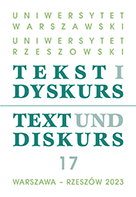Aesthetic speech acts:
their pragmatic status, function, and realization
Aesthetic speech acts:
their pragmatic status, function, and realization
Author(s): Aleksander KiklewiczSubject(s): Pragmatics, Theory of Communication, Philology
Published by: Instytut Germanistyki Uniwersytetu Warszawskiego
Keywords: pragmalinguistics; communication; literary pragmatics; persuasion; aesthetic speech acts;
Summary/Abstract: The subject matter of this article concerns the interpretation of texts and statements of anaesthetic nature in the light of pragmatics, i.e. as aesthetic speech acts. The author treats aestheticspeech acts as stimulating ones, which are opposed to both representative acts and determinativeacts (especially, directive ones). A characteristic feature of stimulating speech acts is their persuasivenature, i.e. such a language action that induces and encourages the addressee to experience emotionsbut does not influence them in a volitional way. Aesthetic reactions are self-steering and do not dependon the subject’s will. Therefore, the realization of aesthetic speech acts, in comparison with other acts,is specific: it is not possible to use specialized (lexical or grammatical) exponents of the illocutionaryfunction, e.g. performative verbs. To perform the aesthetic function, various elements of the planof content and the plan of expression are used, which suggest the aesthetic intention of the sender:1) the semantic content of the text or utterance; 2) its form and structure; 3) context and communicationsituation; and 4) translation of text/message, including the media. Due to their functional and formalfeatures, aesthetic speech acts are divided into several subtypes: 1) macro-, meso- and micro-acts;2) free and complementary acts; and 3) communicative and non-communicative acts.
Journal: tekst i dyskurs – text und diskurs
- Issue Year: 2023
- Issue No: 17
- Page Range: 123-150
- Page Count: 28
- Language: English

